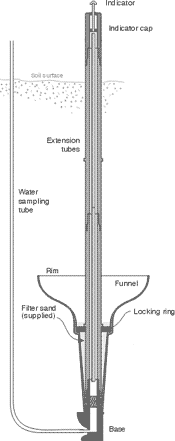|
|
||
|
|

Water in the soil is adsorbed to soil particles and held in soil pores. Drops of water hit the soil during rainfall or irrigation and then move down through the soil as films of water around soil particles. If you dig a hole, drops of water will not appear on the sides of the hole, unless you are below the water-table. This is because the soil holds or attracts the water. In other words the water in the soil is under a suction. When a wetting front reaches the FullStop, the soil gets wetter and wetter. We call this convergence. At the base of the funnel the soil gets completely saturated, so drops of water start to form. The water flows through the mesh screen in the base and into the float reservoir. The indicator floats on this water and then locks into the up position with a pair of magnets. If you stand in shallow water with long cotton trousers, water will 'wick' up the material against the force of gravity. In the same way, water will wick up and out of the funnel if the soil around the Wetting Front Detector is drier than the soil inside the funnel. The indicator can then be reset and the FullStop is ready for the next irrigation event. The operation of the FullStop is a little more complex than described above because the FullStop acts as an obstacle to the downwards path of infiltrating water. Some water is diverged around the funnel and some collected in it. When 20 ml of water has been collected, the indicator float will rise. |
|